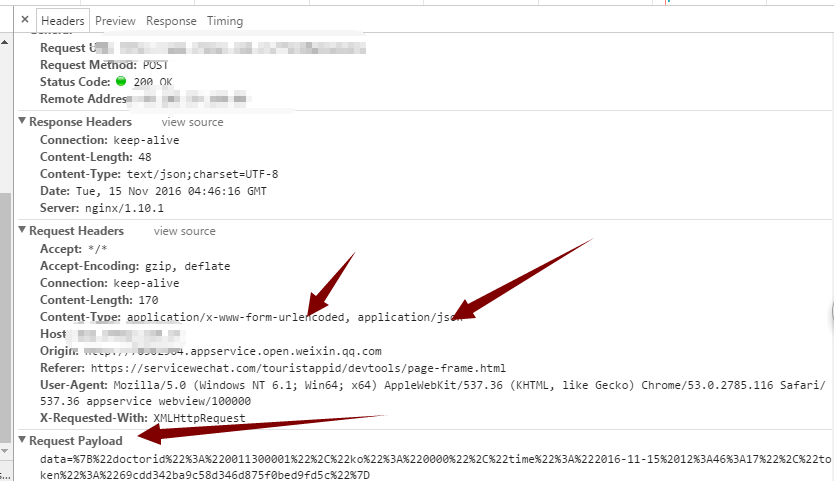这篇文章给大家分享的是有关微信小程序网络请求封装的示例分析的内容。小编觉得挺实用的,因此分享给大家做个参考,一起跟随小编过来看看吧。
在这里首先声明一个小程序文档的bug,导致大伙们在请求的时候,服务器收到不到参数的问题
示例代码:
wx.request({
url: 'test.php', //仅为示例,并非真实的接口地址
data: {
x: '' ,
y: ''
},
header: {
'Content-Type': 'application/json'
},
success: function(res) {
console.log(res.data)
}
})其中header 中的Content-Type,应该用小写content-type才能让服务器收到参数。让我折腾的好久,改了服务器仍然不行,原来是这个问题。参数在request payload中,服务器不能收到,使用如下转换之后
function json2Form(json) {
var str = [];
for(var p in json){
str.push(encodeURIComponent(p) + "=" + encodeURIComponent(json[p]));
}
return str.join("&");
}
最终还是认为是content-type的问题。最后改小写就ok,觉得微信这么牛逼的团队,犯了一个很低级 的错误,把我开发者折腾的爬了。不说,上代码吧。
1 、Http请求的类
import util from 'util.js';
/**
* url 请求地址
* success 成功的回调
* fail 失败的回调
*/
function _get( url, success, fail ) {
console.log( "------start---_get----" );
wx.request( {
url: url,
header: {
// 'Content-Type': 'application/json'
},
success: function( res ) {
success( res );
},
fail: function( res ) {
fail( res );
}
});
console.log( "----end-----_get----" );
}
/**
* url 请求地址
* success 成功的回调
* fail 失败的回调
*/
function _post_from(url,data, success, fail ) {
console.log( "----_post--start-------" );
wx.request( {
url: url,
header: {
'content-type': 'application/x-www-form-urlencoded',
},
method:'POST',
data:{data: data},
success: function( res ) {
success( res );
},
fail: function( res ) {
fail( res );
}
});
console.log( "----end-----_get----" );
}
/**
* url 请求地址
* success 成功的回调
* fail 失败的回调
*/
function _post_json(url,data, success, fail ) {
console.log( "----_post--start-------" );
wx.request( {
url: url,
header: {
'content-type': 'application/json',
},
method:'POST',
data:data,
success: function( res ) {
success( res );
},
fail: function( res ) {
fail( res );
}
});
console.log( "----end----_post-----" );
}
module.exports = {
_get: _get,
_post:_post,
_post_json:_post_json
}2、测试用例
2.1 get请求
//GET方式
let map = new Map();
map.set( 'receiveId', '0010000022464' );
let d = json_util.mapToJson( util.tokenAndKo( map ) );
console.log( d );
var url1 = api.getBaseUrl() + 'SearchTaskByReceiveId?data='+d;
network_util._get( url1,d,
function( res ) {
console.log( res );
that.setData({
taskEntrys:res.data.taskEntrys
});
}, function( res ) {
console.log( res );
});2.2 POST请求
//Post方式
let map = new Map();
map.set( 'receiveId', '0010000022464' );
let d = json_util.mapToJson( util.tokenAndKo( map ) );
console.log( d );
var url1 = api.getBaseUrl() + 'SearchTaskByReceiveId';
network_util._post( url1,d,
function( res ) {
console.log( res );
that.setData({
taskEntrys:res.data.taskEntrys
});
}, function( res ) {
console.log( res );
});
效果

感谢各位的阅读!关于“微信小程序网络请求封装的示例分析”这篇文章就分享到这里了,希望以上内容可以对大家有一定的帮助,让大家可以学到更多知识,如果觉得文章不错,可以把它分享出去让更多的人看到吧!
免责声明:本站发布的内容(图片、视频和文字)以原创、转载和分享为主,文章观点不代表本网站立场,如果涉及侵权请联系站长邮箱:is@yisu.com进行举报,并提供相关证据,一经查实,将立刻删除涉嫌侵权内容。